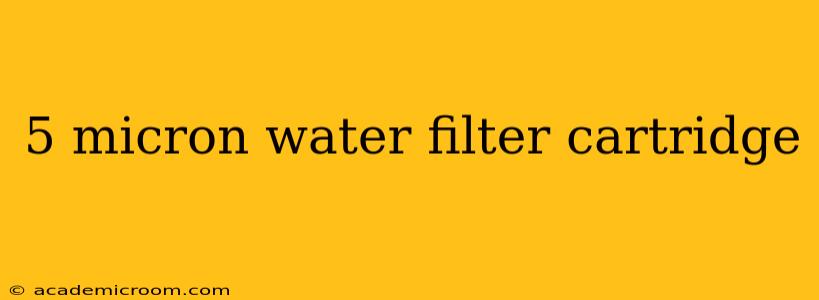A 5-micron water filter cartridge is a common component in many water filtration systems, offering a crucial level of protection against sediment and other larger particles. Understanding its capabilities, limitations, and applications is vital for ensuring you're getting the best possible water quality. This comprehensive guide explores everything you need to know about 5-micron water filter cartridges.
What is a 5-Micron Water Filter Cartridge?
A 5-micron water filter cartridge is a filtration device designed to remove particles larger than 5 microns (5 millionths of a meter) from water. This translates to relatively large particles, including:
- Sediment: Sand, silt, rust, and other suspended solids are effectively removed.
- Larger microorganisms: Some larger protozoa and cysts might be filtered out, although a 5-micron filter isn't designed for complete microbiological protection.
Think of it as a first line of defense in your water filtration system, pre-filtering the water before it reaches more sensitive and precise filtration stages. It extends the life of downstream filters by preventing them from clogging with larger debris.
What are 5-Micron Water Filters Used For?
5-micron water filter cartridges find application in a wide range of settings, including:
- Pre-filtration in whole-house systems: Protecting more expensive reverse osmosis (RO) or carbon filters from premature wear and tear.
- Point-of-use filters: Providing cleaner, sediment-free water for drinking, cooking, or other specific applications.
- Industrial processes: Removing sediment from water used in manufacturing, cleaning, or other industrial applications.
- Aquariums: Keeping the aquarium water clear and free of large particles.
Their versatility makes them a staple in many water purification setups.
How Does a 5-Micron Water Filter Cartridge Work?
These cartridges typically employ a physical barrier to remove particles. Common filter media include:
- Wound or pleated polypropylene fibers: These create a dense matrix that traps particles larger than 5 microns.
- String-wound cartridges: Similar to wound polypropylene, offering robust particle removal.
Water passes through the filter media, and particles larger than 5 microns are trapped within the matrix. Smaller particles pass through.
What are the Advantages of Using a 5-Micron Water Filter Cartridge?
- Sediment removal: The primary benefit is the efficient removal of visible sediment, improving water clarity and aesthetics.
- Extended filter life: Protecting downstream filters from premature clogging leads to cost savings and less frequent filter replacements.
- Cost-effective: Relatively inexpensive compared to other filter types, making them an accessible option for various budgets.
- Ease of installation and replacement: Most 5-micron cartridges are designed for easy installation and replacement, requiring minimal technical expertise.
What are the Limitations of a 5-Micron Water Filter Cartridge?
- Limited microbial protection: A 5-micron filter does not remove bacteria, viruses, or most cysts effectively. Additional filtration stages are necessary for microbiological safety.
- Doesn't remove dissolved solids: It doesn't address dissolved minerals, chemicals, or other substances dissolved in the water.
- Potential for clogging: Depending on the water source, frequent replacements might be necessary if sediment levels are high.
How Often Should I Replace My 5-Micron Water Filter Cartridge?
The frequency of replacement depends largely on the water quality and usage. Factors to consider include:
- Water source: Water with high sediment levels will necessitate more frequent changes.
- Usage: Higher water usage will lead to faster filter saturation.
- Manufacturer recommendations: Always refer to the manufacturer's guidelines for the recommended replacement schedule.
Regular inspection can help you determine when replacement is needed. Look for a noticeable decrease in water flow or a cloudy appearance of the filtered water.
What is the difference between a 1-micron and a 5-micron filter?
A 1-micron filter is significantly more precise, removing particles down to 1 micron. This means it removes much smaller particles than a 5-micron filter, resulting in clearer water and potentially better protection against some smaller microorganisms. However, a 1-micron filter will clog more quickly and is generally more expensive. A 5-micron filter is a good compromise for removing larger sediment while being more cost-effective and less prone to clogging. The choice between them depends on the specific needs and water quality.
Can a 5-micron filter remove chlorine?
No, a 5-micron filter is designed to remove sediment and larger particles. It does not remove chlorine or other dissolved chemicals. To remove chlorine, you would need a filter containing activated carbon.
Are 5-micron filters good for drinking water?
5-micron filters are a good first step in improving drinking water quality by removing visible sediment and improving clarity. However, they do not remove all contaminants and are not sufficient on their own for safe drinking water. Additional filtration stages, such as carbon filtration and potentially reverse osmosis, are usually necessary for removing dissolved chemicals, microorganisms, and other potential health hazards.
This guide provides a comprehensive overview of 5-micron water filter cartridges. Remember to always consult the manufacturer's instructions for your specific cartridge and consider your individual water quality and needs when selecting a filtration system.
